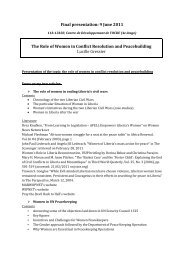Women's Economic Opportunity Index - Economist Intelligence Unit
Women's Economic Opportunity Index - Economist Intelligence Unit
Women's Economic Opportunity Index - Economist Intelligence Unit
- No tags were found...
You also want an ePaper? Increase the reach of your titles
YUMPU automatically turns print PDFs into web optimized ePapers that Google loves.
Appendix IWomen’s economic opportunityA new global index and ranking61. ibid.62. Consultative Group to Assistthe Poor (2009), op. cit.63. P Dupas and J Robinson,“Savings Constraints andMicroenterprise Development:Evidence from a Field Experimentin Kenya”, MIT Poverty ActionLab: Cambridge MA, 2009.64. M Bruhn and I Love, “The<strong>Economic</strong> Impact of Bankingthe Unbanked: Evidence fromMexico”, World Bank PolicyResearch Working Paper No.4981, World Bank: WashingtonDC, 2009.65. “The Role of Postal Networksin Expanding Access toFinancial Services”, DiscussionPaper, World Bank GlobalInformation and CommunicationTechnologies Department:Washington DC, 2006.for services such as cheque books or automatic teller machine (ATM) use. Average charges across theboard were much higher in Africa than in East Asia (US$4 versus 50 US cents). 61 The report found that suchcosts were a factor in the number of bank accounts opened in a country.Only 20 of 139 countries surveyed in 2009 by CGAP had banking regulations in place that madeprovision of basic, low-fee accounts to low-income clients compulsory. Among developing countries,these include India, Pakistan, Malaysia, Argentina, Chile, Colombia and Mexico. So far, survey data do notshow a significant difference in the number of accounts per person in countries with and without basicbanking. 62 However, country-level studies show some positive economic results in providing basic savingsprogrammes to women.For example, a recent randomised evaluation in Kenya tested the impact of formal savings accountson how small-scale entrepreneurs save and use their money. 63 Anecdotally, many individuals in poorcountries say that they find it hard to save, given the many demands on their income. The researchersfor this project tested whether savings constraints prevent microentrepreneurs from expanding the sizeof their businesses. The researchers opened interest-free savings accounts in a local village bank for arandomly selected sample of 185 poor daily income earners (such as market vendors, bicycle taxi driversand self-employed artisans) and collected a unique dataset from self-reported logbooks that respondentsfilled out daily.What they found, if applicable to other countries, is relevant to policies to improve women’s economicopportunity. Despite the fact that the savings accounts paid no interest and featured substantialwithdrawal fees, take-up and usage was high among women. After about six months, access to a savingsaccount led to a 39% increase in productive investment and a 13% increase in food expenditure amongwomen microentrepreneurs in Kenya, suggesting that higher investment levels led to higher incomelevels. They also found evidence suggesting that women in the control group draw down their workingcapital in response to health shocks, and that the accounts enabled the treatment group to cope withthese shocks without having to liquidate their inventories.In Mexico, a unique event—the opening of multiple branches of a new bank targeting lower-incomeindividuals—allowed researchers to evaluate the effect of increased access to financial services onentrepreneurial activity, employment and income for low-income people. 64 Banco Azteca openedbranches in all of the existing stores of its parent company, Grupo Elektra, a large consumer goodsretailer. Almost overnight, Banco Azteca established more than 800 branches. Results showed thatinformal business ownership increased significantly for men in municipalities where the new bankopened, and that there was also an increase in women being employed as wage-earners (more so thanmen). Total employment, including informal business owners and wage earners, rose by 1.4% for theoverall sample, and income levels for both women and men rose by about 7%.ii) Provision by private operators of financial services at post officesThe world’s vast postal network can be leveraged to provide access to financial services to underservedmarkets. The World Bank reports that there are 500,000 post offices in the developing world—twice thenumber of bank branches in the same countries—and that they have a greater reach into rural and poorareas than banks. 65 In Brazil, for example, this reach has allowed Banco Postal to open more than 5m new114 <strong>Economist</strong> <strong>Intelligence</strong> <strong>Unit</strong> 2010




